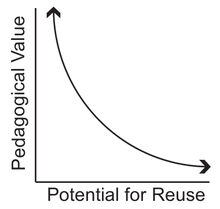When I started teaching my first classes, more than 10 years ago, I often felt insecure and nervous. What if the students asked questions I couldn’t answer or if I got so nervous that I was lost in the middle of the lecture? To feel more secure, my slides were so overloaded with “complete-sentence” bullet points that they could probably have been published and understood without my participation as a teacher. But back then, I wasn’t even familiar with the concept of open resources.
Now, when I am a more confident teacher and have learnt what works and not in the class room, my slides are there just to support the audience in following the structure of my lectures. They often contain no more than the outline and the subject headings, possibly one or two really important definitions, and one or two take-home messages that I keep repeating throughout the lecture.
I realize that my “old” slides would have been very useful as an open educational resource, since you didn’t even have to attend the lecture to understand them. But what about my “new” slides?
Students need context to learn, and when I teach students they see me as a medical doctor or researcher from their department and potentially also as a role-model, which may enhance their learning. Moreover, I can relate to other areas they have just been introduced to- “as my colleague Peter explained to you yesterday…”.

Wiley’s paradox states that reusability and pedagogical effectiveness of learning objects are completely orthagonal to each other. I think that my personal experience shows just that. What works really well for my learners in the class room- less busy slides, more spontaneous interaction with the teacher- hinders dissemination of my slides as simple learning objects.
Luckily, there are new technical solutions available today that make audio and video content easier to make, so that learners outside my class room could potentially take part of the same lecture as the learners in my class room. Perhaps I should try to add a voice recording to my next lecture when sharing it on Slideshare?
Reference: Wiley, D. (2004). The Reusability Paradox. Connexions http://cnx.org/contents/dad41956-c2b2-4e01-94b4-4a871783b021@19.
 I missed this week’s PBL-meeting and the webinar and am trying to catch-up during spare time between meetings and patients, using the different online resources.
I missed this week’s PBL-meeting and the webinar and am trying to catch-up during spare time between meetings and patients, using the different online resources.
 This is the first week of the
This is the first week of the 